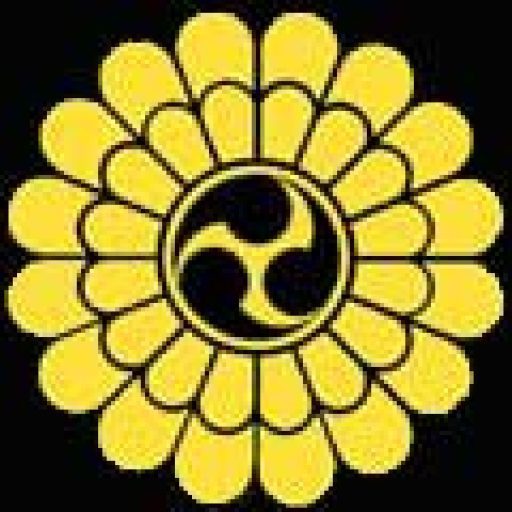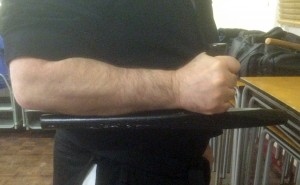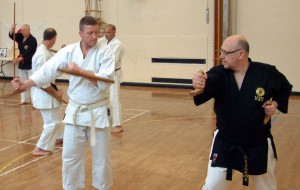The 4th article was published on the Tunkua – side handle batton.
Introduction

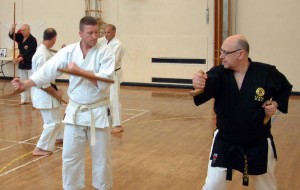 In our Matayoshi Kobudo Kodokan International (M.K.K.I.) budo organization this weapon is known as Tunkua, but it is also commonly known as Tonfa (or Tunfa). However there are old documents that mention this weapon as Tuifa. The Tunkua is a side handle baton, very similar to the modern day American PR-24 baton. In fact the PR-24 baton was most likely derived from the Tunkua.
In our Matayoshi Kobudo Kodokan International (M.K.K.I.) budo organization this weapon is known as Tunkua, but it is also commonly known as Tonfa (or Tunfa). However there are old documents that mention this weapon as Tuifa. The Tunkua is a side handle baton, very similar to the modern day American PR-24 baton. In fact the PR-24 baton was most likely derived from the Tunkua.
Although this weapon appears to be similar to the Sai in its application as a form of truncheon, its feel is remarkably different. Again as with the Sai, the Tunkua is used in pairs which can be flipped out and retracted in depending upon the technique being delivered. Because of this rotation within the grip of the student it is very important that the weapon is of the correct size and balance. My first pair of Tunkua was one of the mass made types and was not well balanced or fitted well in my hand. Because of this I began to take a strong dislike to the weapon. It has been since that I’ve had good tuition in the Tunkua, and have purchased myself a handmade pair which fits my grip, and providing good balance that I now have more respect for the weapon and its capabilities. So I must stress that anyone that wants to train in Tunkua-jutsu they need to get themselves and pair of Tunkua that fits them.
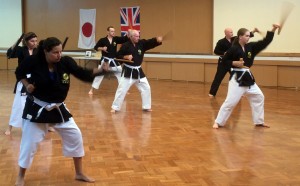
 This weapon is the third in the Matayoshi Kobudo series and I think that the reason for this is due to the movement of the body that the students needs to develop in order to perform the blocks and strikes with devastating efficiency. Much more use of the wrist, shoulder and hips are required. Again as with the Sai it is a close combat weapon, instilling the student with the skills of the correct maai (proper distance).
This weapon is the third in the Matayoshi Kobudo series and I think that the reason for this is due to the movement of the body that the students needs to develop in order to perform the blocks and strikes with devastating efficiency. Much more use of the wrist, shoulder and hips are required. Again as with the Sai it is a close combat weapon, instilling the student with the skills of the correct maai (proper distance).
History of the Tunkua
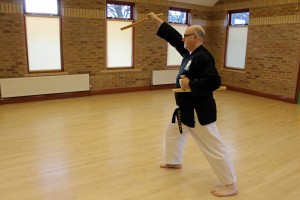 The Tunkua is strongly associated with Okinawan Kobudo derived from a farmer’s tool and used to defend against ruling samurai. However, its origin is strongly debated. It is known to be cited in China, Thailand and Indonesia. One of the debated origins of the Tunkua is from the development of the weapon known as Mae Sun Sawk which was brought to Okinawa from Thailand. It has some similarities to the Tunkua in looks and the weapon is used as club. However, it can’t be flipped out as the Mae Sun Sawk is strapped to the arm. In my opinion I prefer the theory that the Tunkua origin was derived from the Okianawn’s agricultural farmer tool. It is thought to be the handle that was wedged into the side of the large milling stone that was used in the grinding of rice and grain. Other theories have been said that it has been developed from hooks for hanging pots over a table, or a short hand held hoe. Where ever the development of the Tunkua originated from it was used as an efficient self-defence weapon with devastating consequences. And like most Okinawan kobudo weapons of that period was practiced in secrecy from the powerful Shogunate.
The Tunkua is strongly associated with Okinawan Kobudo derived from a farmer’s tool and used to defend against ruling samurai. However, its origin is strongly debated. It is known to be cited in China, Thailand and Indonesia. One of the debated origins of the Tunkua is from the development of the weapon known as Mae Sun Sawk which was brought to Okinawa from Thailand. It has some similarities to the Tunkua in looks and the weapon is used as club. However, it can’t be flipped out as the Mae Sun Sawk is strapped to the arm. In my opinion I prefer the theory that the Tunkua origin was derived from the Okianawn’s agricultural farmer tool. It is thought to be the handle that was wedged into the side of the large milling stone that was used in the grinding of rice and grain. Other theories have been said that it has been developed from hooks for hanging pots over a table, or a short hand held hoe. Where ever the development of the Tunkua originated from it was used as an efficient self-defence weapon with devastating consequences. And like most Okinawan kobudo weapons of that period was practiced in secrecy from the powerful Shogunate.
 Matayoshi Shinko Sensei learnt Tunkua-jutsu from the Irei Sensei of Nozato Chatan village, and passed down his knowledge to us through his son Matayoshi Shinpo Sensei and the Kodokan in Okinawa.
Matayoshi Shinko Sensei learnt Tunkua-jutsu from the Irei Sensei of Nozato Chatan village, and passed down his knowledge to us through his son Matayoshi Shinpo Sensei and the Kodokan in Okinawa.
Construction of the Tunkua
|
|
Traditionally the Tunkua is made from red oak, but other woods are used. My recent pair has been made from hickory which is said to be an excellent wood for this weapon as it has good hardness, durability and flexibility that is required for the type of partner work that is carried out in MKKI.
The shape of the Tunkua varies in style, the most common is where the shaft is round in shape and can taper towards
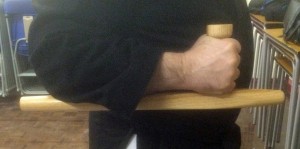
|
both ends. Other is where the shaft is square and although this seems to fit on the forearm better the edges can split over time from constant striking and blocking. There are some that have a mixture of the two, the half round style, where the top of the shaft is flat and the bottom is round. My preference is the submarine shaped shaft, or the contoured style. It combines the features of the tapered squared and round styles. The ends are then tapered off providing a good balance. Because there are no sharp ends the tunkua can withstand more punishment that is seen in our MKKI system during partner work. The handles of Tunkua do not vary so much in style. However, in handmade Tunkua some handles are contoured to fit the shape of the hand giving them greater control and hold.
The mass made Tunkua are in my opinion not particularly good and feel unstable in the hand. Firstly the handles are generally too long and the handle itself too thin. Secondly the main shaft is normally too short and don’t cover the forearm. Furthermore the construction of the joint between the handle and forearm is not very strong and comes loose and my split during practice. This was the main reason why I disliked training in Tunkua-jutsu until I got my first handmade pair. So I would highly recommend in getting a pair made. If you do then you will need to make sure that you provide measurements of the size across the hand and the size from your hand grip to your elbow. Then add half to 1 inch on so that the Tunkua protrudes from the elbow when held. Normally the makers of the Tunkua will help you with these measurements.
|
Good fit of handle with handmade Tunkua – fits in the hand |
Poor fit of handle with mass made Tunkua – it’s too long |
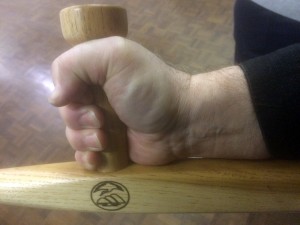 |
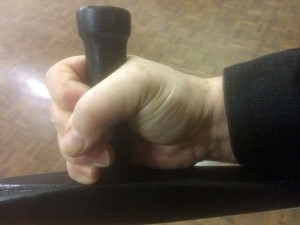 |
The parts of the tunkua are named as follows:
- Monuchi – the main shaft of the Tunkua.
- Zento or Zen Atama – the head of the Tunkua near to the handle.
- Nigiri or Tsuka – the grip or handle
- E-gashira or Tsukagashira- the grip head on the handle
- Sokumen – the side of the shaft
- Jomen – the top of the shaft, same side as the handle is on.
- Monuchi Zoko – the side of the shaft opposite to the handle
- Koto or Ushiro Atama – Bottom end of the shaft furthest away from the handle
- Hoshi – the rivet, some Tunkua don’t have these.
Fundamentals of Matayoshi Tunkua-jutsu
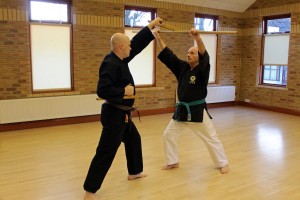
 The Tunkua has a close similarity to that of the Sai where they are used in pairs, and are also a close range weapon. So the user will have to get in close to perform the variety of blocking, clubbing, striking, thrusting and posture breaking techniques. They are normally held in the retracted position, gripping the handle with the monuchi running down the forearm. It is important that the monuchi remains touching the forearm when held in this way, especially when blocking otherwise they can compound the incoming strike on the forearm is the monuchi drifts away. To ensure this doesn’t happen the user must always have a tight grip paying particular attention to the little fingers. The grip only becomes loose when the Tunkua are flipped out for the strikes, thrusts and blocks using the length of the Tunkua.
The Tunkua has a close similarity to that of the Sai where they are used in pairs, and are also a close range weapon. So the user will have to get in close to perform the variety of blocking, clubbing, striking, thrusting and posture breaking techniques. They are normally held in the retracted position, gripping the handle with the monuchi running down the forearm. It is important that the monuchi remains touching the forearm when held in this way, especially when blocking otherwise they can compound the incoming strike on the forearm is the monuchi drifts away. To ensure this doesn’t happen the user must always have a tight grip paying particular attention to the little fingers. The grip only becomes loose when the Tunkua are flipped out for the strikes, thrusts and blocks using the length of the Tunkua.
There is another grip change whereby the Tunkua is flipped around the hand and is caught by the monuchi allowing the handle to be used as a hook or for hitting. However the danger of this is that the handle is the weakest point and could come away from the monuchi.
To impart the power and speed of these techniques the user needs to apply the correct movement from the hips, shoulder and wrist. The user then needs to develop control over the Tunkua as it is flipped in order to stop the circular motion of the monuchi. The body then goes through a kime (focus) when the strike or block lands. All this is what makes Tunkua-jutsu more of a weapon for the practitioner that has been training a while in kobudo.
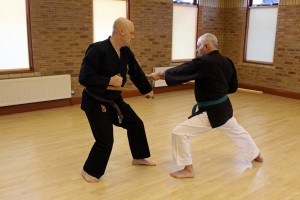
 As with all kobudo weapons the Tunkua requires good control, form, and good body condition. It strengthens muscles in your hand grip and forearm which only enhances the empty hand systems. My students say that my claw hand is very painful, and I think this is down to gripping and using kobudo weapons. There are a lot of positives in the training of kobudo that only assists martial artist in their empty hand systems and the strong body conditioning is just one of these. Controlling the varied strikes and blocks and using kime helps the body develop.
As with all kobudo weapons the Tunkua requires good control, form, and good body condition. It strengthens muscles in your hand grip and forearm which only enhances the empty hand systems. My students say that my claw hand is very painful, and I think this is down to gripping and using kobudo weapons. There are a lot of positives in the training of kobudo that only assists martial artist in their empty hand systems and the strong body conditioning is just one of these. Controlling the varied strikes and blocks and using kime helps the body develop.
In the Matayoshi Kobudo Kodokan system these various techniques are taught via Tunkua No Hojo Undo, the Tunkua Kata Dai Ichi and Dai Ni, and various Bunkai. The student learns the important Maai, distance and timing, against the various weapons they come against. In addition they learn the advantage of deflection and of posture breaking prior to their counter. This is important as the MKKI use full contact with these weapons.
